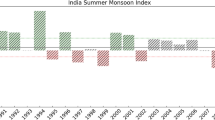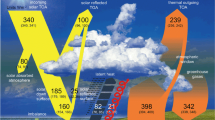Abstract
It is suggested that the gross mean vertical structure of the undisturbed tropical atmosphere may be understood in terms of convective boundary layers driven in different ways and on different time scales by the evaporation of water from the sea surface. The mixed layer on a short time scale is driven partly by the buoyancy produced by the light weight of the water vapor; the trade cumulus layer on an intermediate time scale by the buoyancy (but not heating) produced by the condensation of the water vapor in shallow trade cumulus clouds; and the troposphere itself on a long time scale by the buoyancyand heating produced by the condensation of the water vapor in the deep cumulonimbus clouds.
Similar content being viewed by others
References
Arakawa, A. andSchubert, W. (1974),Interaction of a cumulus cloud ensemble with the large-scale environment, Part 1. J. Atmos. Sci.31, 674–701.
Augstein, E., Riehl, H. Ostapoff, F. andWagner, V. (1973),Mass and energy transports in an undisturbed Atlantic trade-wind flow. Monthly Weather Review101, 101–111.
Augstein, E., Schmidt, H. andOstapoff, F. (1974),The vertical structure of the atmospheric planetary boundary layer in undistrubed trade winds over the Atlantic ocean. Boundary Layer Met.6, 129–150.
Ball, F. K. (1960),Control of inversion height by surface heating. Quart. J. R. Met. Soc.86, 483–494.
Betts, A. K. (1973),Non-precipitating cumulus convection and its parameterization. Quart. J. R. Met. Soc.99, 178–196.
Carson, D. J. (1973),The development of a dry inversion-capped convectively unstable boundary layer. Quart. J. R. Met. Soc.99, 450–467.
Cho, H-R. andOgura, Y. (1974),A relationship between the cloud activity and the low level convergence as observed in Reed-Reckers composite easterly wave. J. Atmos. Sci.31, 2058–2065.
Deardorff, J. W. (1972),Numerical investigation of neutral and unstable planetary boundary layers, J. Atmos. Sci.29, 91–115.
Deardorff, J. W. (1973),An explanation of the anomalously large Reynolds stresses within the convective planetary boundary layer. J. Atmos. Sci.30, 1070–1076.
Deardorff, J. W. (1974),Three-dimensional numerical study of the height and mean structure of a heated planetary boundary layer, Boundary Layer Met.7, 199–226.
Gierasch, P., Goody, R. andStone, P. (1970),The energy balance of planetary atmospheres. Geophysical Fluid Dynamics1, 1–18.
Holland, J. Z. andRasmussen, E. M. (1973),Measurements of the atmospheric mass, energy, and momentum budgets over a 500 kilometer square of tropical ocean, Monthly Weather Review101, 44–55.
Lenschow, D. H. (1973),Two examples of planetary boundary layer modification over the Great Lakes. J. Atmos. Sci.30, 568–581.
Lilly, D. K. (1968),Models of cloud-topped mixed layers under a strong inversion. Quart. J. R. Met. Soc.94, 242–309.
Malkus, J. S. (1958),On the structure of the trade-wind moist layer. Papers in Phys. Oceanogr. and Met. Mass. Institute of Tech. and Woods Hole Oceanographic Institute, No. 13, 1–48.
Manabe, S. andMoller, F. (1961),On the radiative equilibrium and heat balance of the atmosphere. Mon. Wea. Rev.89, 503–532.
Rasmussen, E. M. (1972),Seasonal variations of tropical humidity parameters, Chapter 5 in The General Circulation of the Tropical Atmosphere, Volume 1, by Newell, Kidson, Vincent, and Boer MIT Press, 193–238.
Sarachik, E. S. (1974),The tropical mixed layer and cumulus parameterization. J. Atmos. Sci.31, 2225–2230.
Schneider, E. K. (1977),Axially symmetric steady state models of the basic state for instability and climate studies. Part II. Nonlinear calculations. J. Atmos. Sci.34, 280–291.
Sommeria, G. (1974),Numerical simulation of the trade wind layer over the ocean, International tropical meterology meeting. Nairobi, Kenya, 31 Jan–7 Feb 1974, American Meterological Society.
Tennekes, H. (1973),A model for the dynamics of the inversion above a convective boundary layer. J. Atmos. Sci.32, 385–367.
Yanai, M., Esbensen, S. andChu, J. H. (1973),Determination of bulk properties of tropical cloud clusters from large scale heat and moisture budgets, J. Atmos. Sci.30, 611–627.
Author information
Authors and Affiliations
Additional information
May 1985
This paper was issued as a Harvard University report in 1974. For this version only Section 5 has been rewritten. There has been sufficient interest in this work over the years to warrant making it more widely available through the open literature.
Contribution No. 783 from NOAA/Pacific Marine Environmental Laboratory
Rights and permissions
About this article
Cite this article
Sarachik, E.S. A simple theory for the vertical structure of the tropical atmosphere. PAGEOPH 123, 261–271 (1985). https://doi.org/10.1007/BF00877022
Received:
Revised:
Accepted:
Issue Date:
DOI: https://doi.org/10.1007/BF00877022




